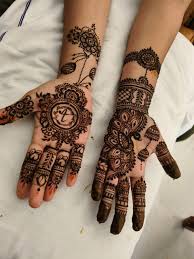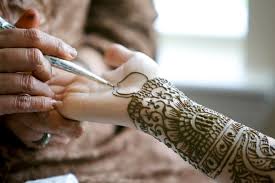
TYPES OF MEHNDI DESIGN

Mehndi designs vary widely based on cultural influences, traditions, and personal preferences. Here are some common types of Mehndi designs:
- Traditional Indian Mehndi: Characterized by intricate patterns that cover the hands and feet entirely. It often includes motifs like paisleys, flowers, peacocks, and intricate lace-like patterns.
- Arabic Mehndi: Known for its bold, floral designs with thick outlines. Arabic Mehndi typically features larger floral motifs and leaves, often covering just the palms or the back of the hands with minimal coverage on fingers.
- Pakistani Mehndi: Combines elements of Indian and Arabic styles. Pakistani Mehndi designs are often intricate and cover a large area, extending up the arms or legs. They incorporate motifs like flowers, paisleys, and intricate patterns.
- Indo-Arabic Mehndi: A fusion of Indian and Arabic styles, featuring bold outlines and intricate patterns like florals, paisleys, and geometric shapes. It often includes bold strokes and shading techniques.
- Moroccan Mehndi: Known for its geometric patterns and designs inspired by Moroccan architecture. It often incorporates bold lines, squares, and triangles arranged in intricate patterns.
- African Mehndi: Reflects the cultural diversity of the African continent, featuring bold patterns and motifs inspired by African art and culture. Designs may include geometric patterns, tribal motifs, and symbolic elements.
- Bridal Mehndi: Elaborate designs applied to the hands and feet of brides for weddings and other special occasions. Bridal Mehndi often features intricate patterns that cover the hands and feet entirely, symbolizing joy, beauty, and auspiciousness.
- Rajasthani Mehndi: Originating from the state of Rajasthan in India, this style is characterized by intricate designs that cover the entire hands and feet. It often includes motifs like peacocks, flowers, and traditional Rajasthani elements.
- Gulf Mehndi: Popular in the Gulf countries, this style features bold and simple designs with thick outlines. Gulf Mehndi often includes floral motifs and geometric patterns, with a focus on the fingertips and the outer edges of the hands.
- Modern Mehndi: Incorporates contemporary elements and trends into traditional Mehndi designs. Modern Mehndi may include motifs like hearts, stars, and other non-traditional elements, catering to personal preferences and individual style.
TYPES OF COLOUR IN MEHNDI

Mehndi, or henna, is traditionally applied in its natural reddish-brown color. However, modern Mehndi artists often use various techniques and ingredients to enhance or alter the color of Mehndi. Here are some types of colors used in Mehndi:
- Natural Henna (Reddish-Brown): This is the traditional color of Mehndi, derived from the leaves of the henna plant (Lawsonia inermis). It stains the skin reddish-brown when applied and left to dry.
- Black Henna: Black henna is not natural henna but rather a mixture containing para-phenylenediamine (PPD), a chemical that produces a black color. However, black henna can cause severe allergic reactions and skin problems for some individuals, so it’s not recommended.
- White Henna: White henna is not actually henna but rather a body paint or adhesive used to create designs similar to traditional henna designs. It typically dries clear or white and can be used as a base for adding other colors or as a standalone design.
- Colored Henna: Mehndi artists sometimes use natural or synthetic dyes to create colored Mehndi designs. These dyes can produce a range of colors such as blue, green, purple, and others. However, it’s essential to ensure that the dyes used are safe for skin application and won’t cause allergic reactions.
- Glitter and Shimmer Mehndi: Mehndi designs can also be embellished with glitter, shimmer, or metallic accents to add sparkle and dimension to the designs. These are often applied on top of traditional Mehndi designs once they have dried.
- Henna Cones: While not a color, henna cones are the tools used to apply Mehndi designs. They contain a paste made from henna powder mixed with water, lemon juice, and essential oils. The consistency and quality of the henna paste can affect the richness and depth of the color produced.
IS MEHINDI IS GOOD FOR SKIN ?

Mehndi, also known as henna, is generally considered safe for the skin when used properly. Here are some potential benefits of Mehndi for the skin:
Cooling Effect: Mehndi paste has a cooling effect on the skin, which can be soothing, especially in hot climates.
Natural Exfoliant: When Mehndi paste dries and flakes off, it can gently exfoliate the skin, removing dead skin cells and leaving the skin feeling smooth.
Antibacterial and Antifungal Properties: Henna has natural antibacterial and antifungal properties, which may help to prevent skin infections and promote skin health.
Natural Hair Dye: Mehndi is often used to dye hair naturally, offering an alternative to chemical hair dyes. It can help condition the hair and scalp while imparting a reddish-brown color.
Temporary Body Art: Mehndi is commonly used for temporary body art, particularly during celebrations and festivals. It allows people to express their creativity and adorn their bodies with beautiful designs.
However, it’s essential to be cautious when using Mehndi, as there are some potential risks and considerations:
Allergic Reactions: While rare, some individuals may be allergic to henna. It’s essential to perform a patch test before applying Mehndi to a larger area of the skin to check for any adverse reactions.
Chemical Additives: Some commercially prepared Mehndi cones may contain additives or chemicals that can cause skin irritation or allergic reactions. It’s advisable to use natural henna paste made from pure henna powder mixed with water and other natural ingredients.
Staining: Mehndi can stain the skin, leaving a temporary reddish-brown color that typically fades over time. While this is desired for decorative purposes, it may be unwanted in certain situations, such as professional settings or formal events.
Longevity: The duration of the Mehndi stain varies depending on factors such as the quality of the henna paste, skin type, and aftercare. In general, Mehndi stains last for about 1-3 weeks before gradually fading away.












Leave a Reply